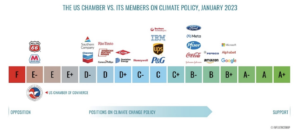
The carbon marketplace is a vital mechanism for companies to align their decarbonization strategies with Paris Agreement targets. Refining it to make it more inclusive is key to the fight against climate change.
Carbon markets are improving. Clear guidelines for how companies both claim emissions reductions and use the resulting credits are enhancing transparency and rigor. Markets are also evolving on the supply side to establish integrity through well-defined standards for the issuance of credits. But there is still room for improvement.
Developing sector-based benchmarks against which all operators in a given industry can participate would open carbon markets to emerging companies. This inclusive step would complement the current project-based approach to issuing credits and mark a significant advance toward achieving Paris Agreement goals.
Under the status quo, emissions are requisite for earning credits
Under the current project-based approach, companies earn carbon credits after implementing technological or operational changes (beyond business as usual) that avoid, reduce or remove greenhouse gas (GHG) emissions. Once a company demonstrates that it has achieved the intended emissions-reduction effect, carbon standard bodies, which manage greenhouse gas crediting programs, can issue credits proportional to the impact of the change on emissions.
Relying on project-based reference points for measuring emissions reductions and issuing credits supports industry incumbents in lowering their carbon footprints. However, this approach as the sole means of generating carbon credits prevents growth-stage companies without large carbon footprints from earning credits at all. From their perspective, credits are issued in a way that incentivizes conventional operations rather than deliberate low-carbon growth from the outset.
Carbon markets for low emissions from inception
To help put emerging industries on low-carbon pathways, carbon standard bodies should build upon their methodologies and adopt sector-based approaches for issuing carbon credits. Under such models, credits could be issued according to how companies perform against industry-wide emissions standards. These credits would be performance-based as opposed to project-based and would focus more on the life cycle emissions of the production of goods and services.
In a big tent approach, where all companies in a sector can be assessed against a rigorous benchmark, even the newest company in an industry would be eligible to earn credits. Moreover, the fact that such a company has never polluted would be a benefit rather than a barrier to the market. Benchmarks would be set based on better-than-average performance and periodically adjusted to drive each sector’s collective emissions downward in line with that sector’s stipulated target, which should be aligned with Science-Based Targets Initiative (SBTI) and other climate action frameworks.
By rewarding both young companies striving to build themselves as low-carbon stars, as well as large incumbents that succeed in reducing their carbon footprints, crediting programs can help a wide array of market participants demonstrate — and profit from — their commitment to continuous improvement.
California’s transportation sector as a model
One example of a sector-based approach in action is California’s low-carbon fuel standard (LCFS), which employs emissions trading as part of its aim to encourage low-carbon fuel for transportation throughout the state.
Individual fuel producers receive carbon intensity (CI) scores, based on an assessment of their fuel’s (or fuels’) life cycle. The CI score represents the carbon intensity of the given fuel’s total pathway (production, transportation, use, etc.). Fuel producers that perform better than the standardized sector-wide benchmark via their own life cycle assessment (LCA) receive credits commensurate with their unique carbon intensity. California then sets an overall sector-wide emissions reduction target below the industry benchmark. An entity that does not reduce its own fuel’s CI to meet the reduction target must purchase LCFS credits.
These credits, based on the carbon intensity of fuel, are carbon credits, albeit ones confined to California’s transportation sector. This limitation notwithstanding, California’s LCFS has led to significant growth in renewable fuel consumption and enabled the state to achieve meaningful decarbonization in transportation. Replicating this model for the broader carbon marketplace has considerably greater potential. Innovative companies across diverse sectors could then benefit from carbon markets as an additional motivation to accelerate their growth with climate-minded operations.
When carbon standard bodies lead, policymakers will follow
Carbon markets have enabled established companies to pair emissions reduction with financial gain. Carbon standard bodies can deepen this impact by making decarbonization more holistic and more standardized via sector-based issuance of credits. Policymakers in turn can amplify these actions with proper oversight and regulation. Stronger crediting programs go hand in hand with the goal of many government officials around the world who seek to achieve low carbon targets for their respective jurisdictions.
Sector-based models alongside the current project-based approach could do wonders for tomorrow’s tech giants, carbon markets and a net-zero carbon economy. Now is the time to implement these models.
- SEO Powered Content & PR Distribution. Get Amplified Today.
- EVM Finance. Unified Interface for Decentralized Finance. Access Here.
- Quantum Media Group. IR/PR Amplified. Access Here.
- PlatoAiStream. Web3 Data Intelligence. Knowledge Amplified. Access Here.
- Source: https://www.greenbiz.com/article/how-more-inclusive-marketplace-can-promote-low-carbon-growth
- :has
- :is
- :not
- :where
- 8
- a
- accelerate
- According
- Achieve
- achieved
- achieving
- across
- Action
- actions
- Additional
- Adjusted
- adopt
- advance
- After
- against
- Agreement
- aim
- align
- aligned
- All
- alongside
- also
- an
- and
- approach
- approaches
- ARE
- around
- Array
- article
- AS
- assessed
- assessment
- At
- avoid
- barrier
- based
- BE
- below
- Benchmark
- benchmarks
- benefit
- Better
- Beyond
- Big
- bodies
- both
- broader
- build
- business
- but
- by
- CA
- california
- CAN
- carbon
- carbon credits
- change
- Changes
- claim
- clear
- Climate
- climate action
- Climate change
- Collective
- commitment
- Companies
- company
- Complement
- consumption
- continuous
- conventional
- could
- Credits
- Current
- cycle
- decarbonization
- Deepen
- demonstrate
- demonstrates
- diverse
- do
- does
- downward
- drive
- each
- earn
- Earning
- economy
- effect
- eligible
- emerging
- Emissions
- employs
- enabled
- encourage
- enhancing
- entity
- establish
- established
- etc
- Even
- evolving
- example
- expressed
- fact
- fight
- financial
- Focus
- For
- from
- Fuel
- Gain
- GAS
- generating
- GHG
- given
- Go
- goal
- Goals
- goods
- Government
- Government Officials
- greater
- greenhouse gas
- Growth
- guidelines
- hand
- Have
- help
- holistic
- How
- However
- HTTPS
- Impact
- implement
- implementing
- improvement
- improving
- in
- incentivizes
- Inclusive
- industries
- industry
- Initiative
- innovative
- integrity
- intended
- issuance
- issue
- Issued
- issuing
- IT
- ITS
- jpg
- jurisdictions
- Key
- large
- lead
- Led
- Life
- limitation
- Line
- Low
- low-carbon
- lowering
- make
- Making
- manage
- many
- mark
- Market
- marketplace
- Markets
- meaningful
- means
- measuring
- mechanism
- Meet
- methodologies
- model
- models
- more
- Moreover
- Motivation
- must
- necessarily
- net-zero
- never
- Newest
- node
- now
- of
- officials
- on
- once
- ones
- open
- operational
- Operations
- operators
- opposed
- or
- Other
- overall
- Oversight
- own
- pair
- paris
- Paris Agreement
- part
- participants
- participate
- pathway
- perform
- performance
- perspective
- perspectives
- plato
- Plato Data Intelligence
- PlatoData
- points
- policymakers
- position
- potential
- prevents
- Producers
- Production
- Profit
- Programs
- project-based
- promote
- proper
- Publishes
- purchase
- put
- range
- rather
- receive
- reduce
- reducing
- reduction
- reductions
- refining
- reflect
- Regulation
- remove
- Renewable
- represents
- requisite
- respective
- resulting
- rewarding
- rigorous
- Room
- s
- score
- scores
- sector
- Sectors
- Seek
- Services
- set
- Sets
- should
- side
- significant
- standard
- standards
- Stars
- State
- Status
- Step
- Still
- strategies
- stronger
- succeed
- such
- supply
- Supports
- Target
- targets
- tech
- tech giants
- technological
- tent
- than
- that
- The
- The State
- the world
- their
- themselves
- then
- There.
- These
- this
- Through
- throughout
- time
- to
- Total
- toward
- Trading
- transition
- Transparency
- transportation
- TURN
- under
- unique
- upon
- use
- via
- views
- vital
- Way..
- WELL
- well-defined
- which
- WHO
- wide
- will
- with
- without
- world
- would
- young
- zephyrnet







